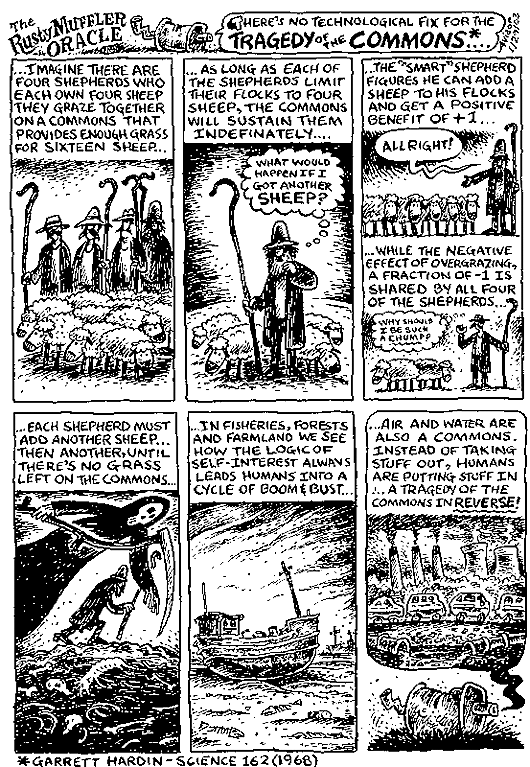Written by Dr Sahil Jai Dutta and Dr Richard Lane
In 2014 The Economist wrote an impassioned editorial about the fate of the planet’s oceans. “Arctic ice now melts away in the summer. Dead zones are spreading. Two-thirds of the fish stocks in the high seas are over-exploited, even more than in the parts of the oceans under national control.” In the oceanic spaces shared by all, sea life was becoming scarce. It was, quite simply, “a tragedy of the commons”. This was a reference to ‘The Tragedy of the Commons’, a famous parable about self-interest and public goods written by American ecologist Garrett Hardin in 1968. It is a foundational article used in countless economics, politics and philosophy modules. It shapes – among many other things – how policymakers conceive of environmental concerns, particularly the challenge of climate change and how best to confront it.
Being foundational doesn’t make it straightforward though, and it is in fact something of a puzzle. The argument Hardin makes in ‘The Tragedy of the Commons’ turns on its head the neoclassical economic notion that the best way to govern social life is to leave self-interested, rational actors to their own devices. Instead, Hardin argues that people making decisions in their own individual self-interest can lead to collective catastrophe. By investigating how individual self-interest came to be seen as a problem rather than a solution at the collective level, we are forced to confront both the Cold War context in which Hardin wrote, and his own particularly unpleasant politics. In doing so it becomes easier to see how the idea of the Tragedy of the Commons can and has been used to legitimate coercive solutions to collective problems.
From the liberal utopia of self-interest
One of the underlying principles behind Adam Smith’s optimistic vision for the market society that was emerging around him was how markets worked to bind self-interested people together. People, liberated from the excesses of an absolutist state, could find a certain harmony through market exchange. Self-interest was socialising. The more people exchanged the more interdependent they became and the more they could empathise with one another.
Smith was never the ‘Greed is Good’ caricature some imagine him to be, but his liberalism represented a broader shift to a social vision where “self-love” was a mechanism to allow people to manage themselves without the need for an overly interventionist state. Neoclassical economics, while dumping many of the broader methodological commitments entailed in classical thinking, nonetheless retained at its core an optimistic view that the interaction of self-interested individuals would lead to stable, optimal, outcomes and guard against the need to establish an external authoritative body.
This is interesting to keep in mind when we turn to ‘The Tragedy of the Commons’, an article Hardin wrote for the journal Science. Published at a time when the American environmental movement was developing around the theme of natural limits to growth, Hardin’s article was driven by the fear that population growth would bring about environmental catastrophe. In the article, Hardin likened the population problem to one of farming on common land. If you have five farmers grazing their cows in one common field, it is in each individual farmer’s rational self-interest to add another cow to their herd. The gain they’ll get – extra milk, extra meat – will be all for themselves, while the loss the cow causes to the land through overgrazing will be shared collectively. For that reason, says Hardin, it makes sense for each farmer to keep on adding cows to the common field. And this eventually brings disaster. With no limit, the cows soon do irreversible damage to the plants they live on, and ultimately the soil is destroyed. By following their own, individually rational self-interest the farmers see their cows starve, then they starve and ultimately the planet starves. It’s a great tragedy.

Encoded in this story is a very different idea of the way self-interest can play out collectively than the one portrayed in classical and neoclassical thought. Self-interested interaction is not the solution to the question of collective governance; instead it is the problem of governance. Unless we find a way to control, coerce, or incentivise self-interest to work in the collective good, it will lead to our collective ruin.
To the dystopia of rational choice
Hardin was not coming from a tradition of liberal economics but a different body of thought: rational choice theory. While rational choice theory is certainly a market-based reading of the social world, it works in a very different way to the market of neoclassical economics. It is all about trying to use markets for the purpose of intervention and control, and so entailed a radical remaking of the discipline of economics.
It is a vision of humanity born in the dark context of Cold War American fears. Here, think-tanks focused on optimal troop deployment, missile management and nuclear war-gaming were struggling to establish techniques of military dominance over the Soviet Union and what they saw as the cancerous global spread of communism. The ideas they were developing were not dedicated to explaining the universal, collective gains Adam Smith thought commercial society would deliver, but instead were focused on how control could be maintained in a context of unpredictability and highly imperfect information.

Nuclear war rendered in game theoretic terms
Through rational choice theory the parable of Smith’s self-interested butcher, baker and brewer freely exchanging their way to commercial utopia was replaced by the parables of the tragedy of the commons and the prisoners dilemma, where competitors – whether persons or some larger grouping such as nation states – are locked into a zero-sum, me-versus-you or us-versus-them competitive struggle. Rather than producing the optimum result by simply acting in their own interests, the competitors ultimately destroy themselves through their individually rational desires.
As such the problem of the commons – where public goods, like street lighting or clean air that are difficult to exclude anyone from enjoying – is understood here as a problem of managing self-interest. And this makes the issue of governance very different. The issue is not to simply implement market rule and sit back as neoclassical economics might imply. Nor is it a case of trying to develop institutions that ensure efficient markets as institutional economics would suggest. Rather it is about trying to harness markets to cajole and control the consequences of self-interest.
Neoliberal reforms have been accompanied by an enormous expansion in monitoring, surveillance, data gathering and coercion.
The great irony here is that rational choice theory is now upheld as a kind of libertarian anti-government fantasy that has led to privatisation, outsourcing, and deregulation. The commonly held idea here is that the era of neoliberal governance that rational choice is associated with is about forcing market competition. But revisiting the tragedy of the commons shows how neoliberalism has been about control, coercion and using markets to better manage that coercion. It is why neoliberal reforms – constructed on the idea of self-interested actors locked into a world-wide prisoners dilemma in everything they do – have been accompanied by an enormous expansion in monitoring, surveillance, data gathering and coercion.
Coercion, lifeboats and Hardin’s nativist politics
This is a good thing to keep in mind if we return to the figure of Hardin. He is these days usually celebrated as a populariser of a fundamental human-ecological problem, or criticised for misunderstanding common pool resources and focusing solely on the application of private property rights and free-market solutions to environmental problems. What goes missing in these two stories is actually the nastier, nativist foundation to his work. If we keep in mind this notion that rational choice theory is about controlling self-interest and the zero-sum us-versus-them necessities of governance, it fits very neatly with Hardin’s panic about population growth.
And in order to see this clearly, we need to view ‘The Tragedy of the Commons’ in the context of Hardin’s later 1974 piece, published in Psychology Today, entitled: ‘Lifeboat Ethics: The Case Against Helping the Poor’. Here, Hardin railed against what he claimed was a misguided environmentalist metaphor of the earth as a spaceship, where all of the planet’s peoples have an equal right to its limited resources. Hardin argued instead that the rich countries of the earth should be thought of like lifeboats, surrounded by the desperately swimming poor of the world. Helping these poor to clamber aboard would swamp the boats and result in everyone drowning. Or as Hardin put it: “complete justice, complete catastrophe”.
Garrett Hardin on standards of living and immigration
Beginning in the late 1940s, the political and popular concern with the poverty and instability of the Global South began to grow. This concern was not focused predominantly on the plight of the people though. There was little thought for the immiseration of a significant part of the world due to continued exploitation through (neo)colonial practices. Instead, this was a concern first and foremost with the success of the US-led capitalist economic order over its Soviet nemesis at the dawning of the Cold War. The US needed to ensure continual access to global natural resources to power both military and economic development. Rapid population growth in the global south, most importantly in India, threatened to both create scarcity and produce instability – the kind of instability that could result in poor countries going ‘red’.
This geopolitically infused neo-Malthusian concern was popularised by the widely read book The Population Bomb by Paul and Anne Ehrlich, published the same year as Hardin’s ‘Tragedy’. In response, Hardin’s proposals to address the rising populations of the Third World and the threat of their swamping the lifeboats of the First included the coercive control of women’s reproduction if needed. And not only women in the Global South, as Hardin was also deeply vexed by the migrant population in America.
Hardin’s work was rooted in a racialised panic about birth rates, one that was only sharpened through the lenses of the Cold War and rational choice. Throughout his life Hardin wrote for two audiences: the scientific community and broader public, for which he is recognised and lauded; as well as nativist organisations and smaller publishers in America. His work was supported by grants from the anti-migration Pioneer Fund and he published in far-right publications like The Social Contract, a nativist magazine founded by anti-immigration activists. It was in these magazines that he vocally expressed his concern that ethnic-European Americans risked being outbred by migrant populations.

This side of Hardin’s work is often absent from the way we study ‘The Tragedy’ today. But by showing how his use of rational choice reframed the question of governance from how to liberate self-interest to how to control it, we can see how it simultaneously obscures the racialised concerns over population during the Cold War period, and how it links to the coercive and neoconservative reality of today’s neoliberal politics. As Hardin himself wrote, “To survive in comfort, we must create a new conservatism”.
Scarcity Resources
Amadea, S.M. (2003). Rationalizing Capitalist Democracy: The Cold War Origins of Rational Choice Liberalism. Chicago: University of Chicago Press.
Erikson, P., Klein, J.L., Daston, L., Lemov, R., Sturm, T and Gordin, M.D. (2013). How Reason Almost Lost Its Mind. Chicago: University of Chicago Press.
Sunderlin, W.D. (2003). Ideology, Social Theory and the Environment. London, New York: Rowman and Littlefield


